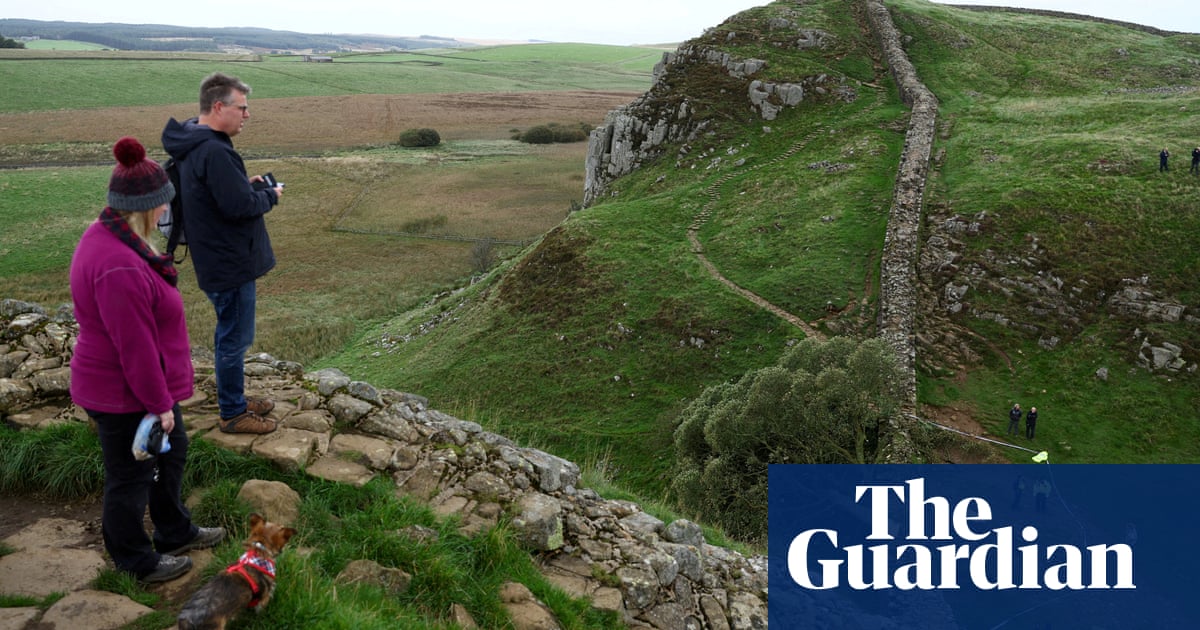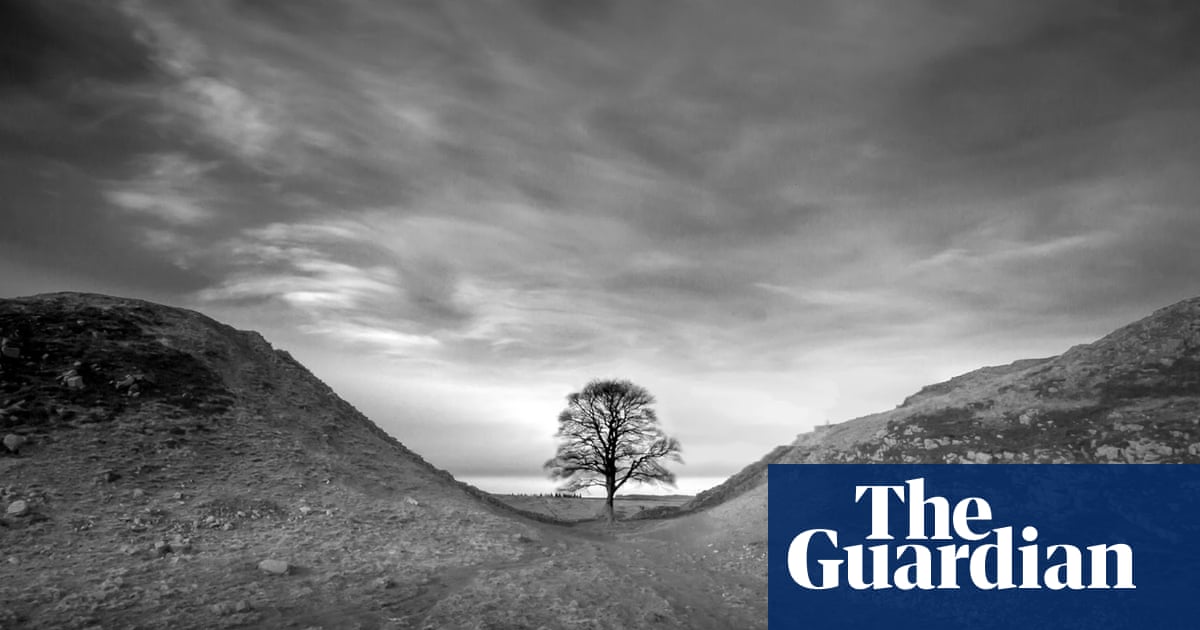
Last Wednesday night, Britain was robbed of one of its best-loved trees. Mike Pratt, the CEO of Northumberland Wildlife Trust, describes the venerable, now-recumbent sycamore at Sycamore Gap on Hadrian’s Wall as a “totem tree; a touch point in the landscape”.
But the tree, standing alone in a national park, also reminded some of how nature-depleted England is. As environmentalist Ben Goldsmith said at the time: “That someone would have destroyed this iconic tree is beyond comprehension; but what’s even more shocking is that this was pretty much the only tree in that entire landscape. Our national parks can and should be so much better.”
According to Northumberland Wildlife Trust’s latest estimates, just 7% of Northumberland meets the criteria needed for the UK government to fulfil its commitment to protect and prioritise 30% of the landscape for nature by 2030 – which is a little higher than the 5% average across England as a whole.
While Goldsmith overstates the case somewhat, low tree cover does partly explain why Northumberland is sometimes called the “land of far horizons”. The most remote and least populated of England’s national parks, its rolling hills are swathed by expansive areas of open moor, peatland, as well as large forestry plantations.
In common with most other national parks in Britain, much of this land is grazed by sheep and cattle. As Pratt explains, over decades and centuries, agriculture has gradually become more intensive, with the result that areas of the national park are now almost devoid of trees and “feel a little bit industrial in parts”, he says. This is not the fault of individual farmers, Pratt argues. “It’s just that no one’s ever made any big decisions about what it should look like, probably since Roman times.”
Now, the felling of the tree at Sycamore Gap has given local communities and land managers a reason to reflect on, and make some serious choices about, how this landscape should look and function in the years to come.
A vision of renewal
From Pratt’s perspective, the corridor of land that roughly follows Hadrian’s Wall, from England’s east coast to west, is “possibly the biggest opportunity for a wilder landscape in England”.
On Wednesday, Northumberland national park authority announced its plans for how one part of that corridor would be renewed, with a new project signalling “a transformative shift towards a nature-first approach to land management”.
The project has been two years in the planning, but unveiling it this week, in the immediate aftermath of loss of the region’s most famous tree, felt like a fitting riposte to that crime. Tony Gates, chief executive of the National Park Authority, explained in a press release that his team decided it was imperative to seize the moment. “We are living through a nature crisis, a climate crisis and a wellbeing crisis,” he writes. “We must use this strength of feeling to drive change, for nature recovery and for our health and wellbeing.”
At the heart of the new project is a 200-hectare block of land, owned by Northumberland National Park Authority, centred on Greenlee Lough, Northumberland’s largest natural body of water, just a few hundred metres to the north of Sycamore Gap. Work will focus on restoring and expanding existing pockets of nature rich-habitats, especially peat bogs, heaths and wetlands, as well as renaturalising watercourses, planting trees and creating new wildlife habitats. Working with a range of partner organisations and local farmers and land managers, the project will aim to drive substantial change “at landscape scale” across a 5,000 hectare segment of Northumberland National Park.
The right trees in the right places
Last week, writer and poet Robert Macfarlane joined Goldsmith in lamenting the fact that the UK uplands are “drastically deforested”. He suggests that the best way to remember the loss of the tree at Sycamore Gap would be “with the gain of the forest”.
Extensive reforestation of the Hadrian’s wall area does not appear to be part of the National Park Authority’s immediate plans, however. Local expert David Morris, area operations manager for Cumbria and the north-east England for the RSPB (not a project partner), says that while more tree cover would certainly be welcome in some areas, blanket coverage of closed-canopy forest is neither achievable nor desirable in this context.
Morris says that far from being an entirely “sheep-wrecked” wasteland, Northumberland and adjoining uplands in Cumbria and the Scottish Borders still harbour precious populations of endangered ‘red-listed” bird species, including curlew and black grouse. These species need extensive areas of undisturbed habitat that are more open and less wooded, for at least some periods of their life cycles.
Morris also points out that planting trees within the extensive tapestry of peat bog that threads through large parts of Northumberland does no good for either biodiversity or carbon sequestration. It’s about having “the right trees, in the right places, for the right reasons,” he says.
Morris appears to broadly share the vision articulated by the Northumberland National Park’s newly announced project: to allow natural processes to recreate a varied mosaic of wildlife-rich habitats. Pratt summarises it as creating a landscape that’s “wetter and a lot fuzzier with vegetation”.
Pratt is, however, determined to ensure ambitions for a nature-led renaissance remain high: “One good project here over 5,000 or 10,000 hectares is still a small bit on the map.” He notes that the UK government’s ‘30x30’ deadline is fast approaching.
Wholesale “rewilding” of this area is, however, not a realistic or an entirely desirable outcome. Firstly, the English borderlands are threaded through with treasured historic monuments – most notably Hadrian’s Wall itself. Secondly, most of this land is managed by farmers and populated by farming communities, whose identities and livelihoods are pinned to the agricultural work they do.
According to Pratt, lots of farmers in the area are eager to do much more to help increase biodiversity and bio-abundance on their landholdings. But they tell him that the new Environmental Land Management Scheme (ELMS) payments do not currently provide sufficient financial incentive for them to adopt nature-friendly practices across the board. This view is echoed by Morris: “There’s a huge amount of interest in the second round of [ELMS] Landscape Recovery schemes,” he says. “We just need to make sure there’s sufficient budget there for farmers and land managers to get paid to deliver.”
Learning to love a messier landscape
If the uplands of Northern England and beyond are to make a successful transition towards a wilder, more nature-rich, less intensively managed future, another crucial shift is needed. Conservation organisations and land managers must find ways to bring broad swathes of the British public along with them. And part of that means helping people find ways to connect with and learn to treasure scrubbier, wetter, less predictable versions of the British countryside.
Pratt seems unfazed by this challenge. “We’ve got to move in this space of community organising,” he says. “It’s all about working with communities and co-designing things, rather than doing things to people”. He is confident that “the excitement will come when people realise just how much nature they will see.” In his view, the most appropriate and enduring riposte to the sickening loss of the much-loved tree at Sycamore Gap will be to “get the landscape singing again”.












